BIOS -
BIOS is an acronym that stands for Basic Input/Output System. It is meant to control your product at a very low level. As of right now there are three regularly used BIOS formats (there are actually more than that but there are three common ones). These are the AMI (American Megatrends Incorporated), Award, and Phoenix. The UEFI BIOS on the P8Z77-V Deluxe is pretty much the same one you will find on Asus’ other channel boards. The options are going to be the same and the settings will also fall into the same spots. Still we have to say that Asus’ implementation of the UEFI BIOS is still one of the best ones that we have worked with (the best for look and smoothness is still the Intel one). You can see how fluid this is along with the options you have in our video below.
Overclocking –
Overclocking on the Asus P8Z77-V Deluxe is just as easy as it is with any other Z77 based board. The idea of overclocking has become so common (not like the days when manufacturers tried to prevent it) that there are tools to push your CPU even if you have never done it before. On Asus products this is called AutoTune. When we ran this on the P8Z77-V Deluxe we managed to hit a high mark of 4.567MHz (103.8x44). This increase was not that bad at all, but we knew that this CPU was capable of much more. In the end we were able to hit our regular high of 4.8GHz (@1.38V) which was stable for the remainder of our testing. All of our attempts to reach 4.9GHz were not successful even with a temporary high voltage of 1.5V at that point the CPU simply hit thermal overload and shutdown. 
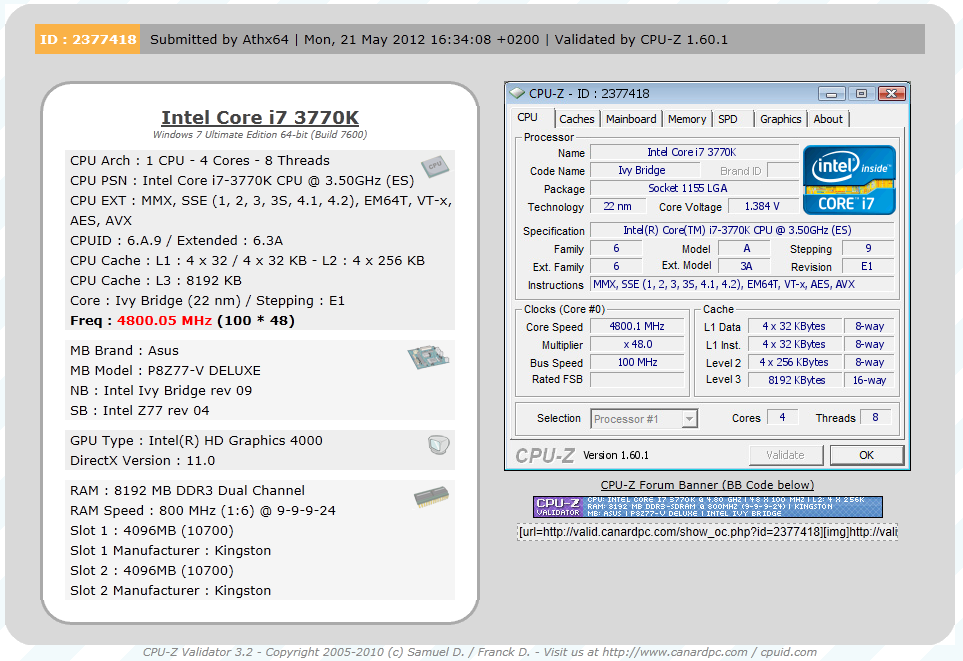
Of course overclocking is a picky subject. I can buy to identical CPUs from the store and they will not always perform the same way under stress. This is the same with motherboards, RAM and GPUs. So again it is important to keep in mind that our results represent a specific hardware configuration. Yours may be similar but will rarely be identical.
Overclocking Tools -
As with the UEFI BIOS, the new tools used for overclocking are becoming more and more complex; Asus themselves has improved their suit of tools and now include so many options, features and items that we could fill several pages of text covering them. So we decided to use video to cover this instead. You can check out everything that is inside the AISuite II application below.
The Test System and Comments -
Our test system is built on an open bench. This has two effects on testing. First it allows us to see everything and also to setup and disassemble the test rigs quickly. Second it means that we cannot gauge the potential air flow found in a normal case. The air is pretty stagnant; some may say this is a great neutral testing method and it can be. However, it does mean that the temperature reading taken off of the components are not accurate to what an average consumer would see. This means that your thermal performance will vary from what we see here..
Setup on a modern system is simple and as we move forward in technology it will become even more so. We have heard that the next generation of Windows (Windows 8) may also be available in USB key form. This means that installation is going to be even faster. As it stands the installation of the OS and drivers for the Asus P8Z77-V Deluxe was ridiculously simple.
We do recommend doing a custom installation so you do not end up with Google’s Chrome, Google Desktop, and Norton as your antivirus, but if you are building your own system you really should be doing that anyway. You will also want to check for updated drivers using the Asus Update utility in AI Suite II to make sure you have the latest ones, but really keeping your system up to date goes for ANY motherboard.
Performance testing overview -
Our testing is a little different than most. We combine both synthetic and real-world applications to simulate the types of performance common to the individual products. For motherboards this means that we run roughly six synthetic tests and two real-world. We will be expanding the real-world testing in the near future. But there is more to performance than just the raw numbers. As there are multiple components and sub-components on a motherboard there each item can have a distinct impact on the way the product will perform once you get it in your system. It is important to note not only the actual results but what they mean to you as a potential consumer. We will try to give this information to you.
But we do not just cover the performance aspects that are measurable. We also talk about the components that might not have a direct benchmark. These are items like Audio Quality, ease of use and installation.
Section 1 Subsystems
Memory -
Memory performance is very important on a motherboard, especially when you have a CPU with multiple cores and threads. If you have slow memory your cores and threads can become starved for data to execute. To test memory performance we run both Sisoft’s SANDRA and AIDA64. These two combine to not only give us accurate numbers but to validate each other. For testing at stock speeds the memory is hard set to 1333MHz while overclocking testing is done at the highest stable speed for the voltage of 1.65v this is due to the different memory dividers for each CPU. As such, the memory speeds will vary greatly. This means that the overclocked numbers are a little misleading and while they can show a trend are really only included to show if a board has a problem with memory performance at high clockspeeds.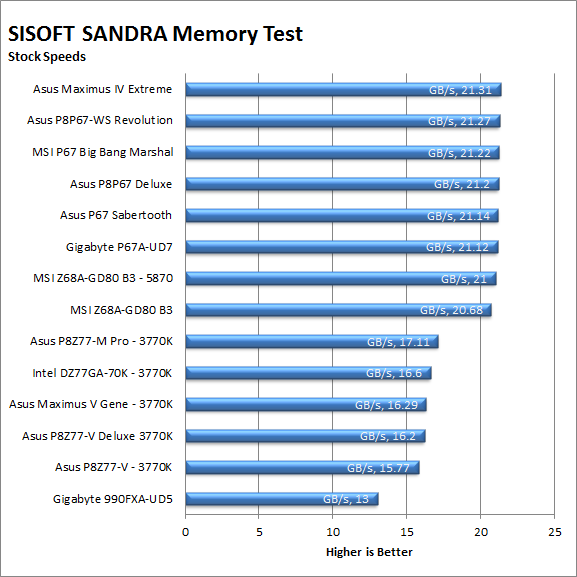
The Asus P8Z77-V Deluxe falls into line with the other Z77 based boards running our 3770K. It is not the fastest of the group, but it is also not far behind. Still the memory performance we see here should help the P8Z77-V Deluxe (we will call it the –V Deluxe moving forward) get through most of our tests without any issues.
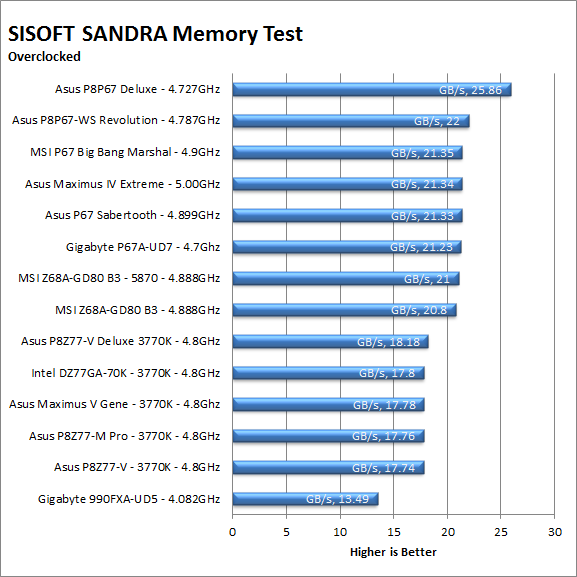
Drive performance -
Drive performance is also one of the major subsystems that goes to make up the performance of a motherboard. For our testing we use Sandra and AIDA64 again. We only test with single drives for each type of controller present on the motherboard (unless it is a professional product where we will use RIAD 5 and/or 10). We have also begun using a Seagate PS-110 USB 3 external HDD and a Kingston HyperX USB 3.0 Flash drive for our USB 3.0 performance. As a side note, we include the overclocked numbers here to make sure (again) that you are not going to see a major drop in performance due to minor instabilities at high clock speeds.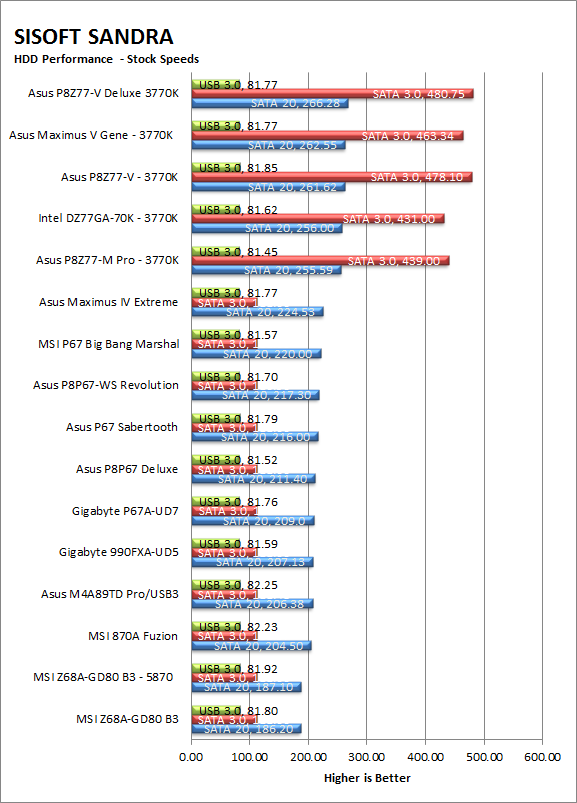
Under our stock run for drive testing we found that the –V Deluxe was at the top of the pile with a SATA 2.0 speed of 266.28 and a SATA 3.0 speed of 480.75. This should help with tasks like transcoding, image manipulation, application installation and loading as well as a few other tasks that require fast access to storage. 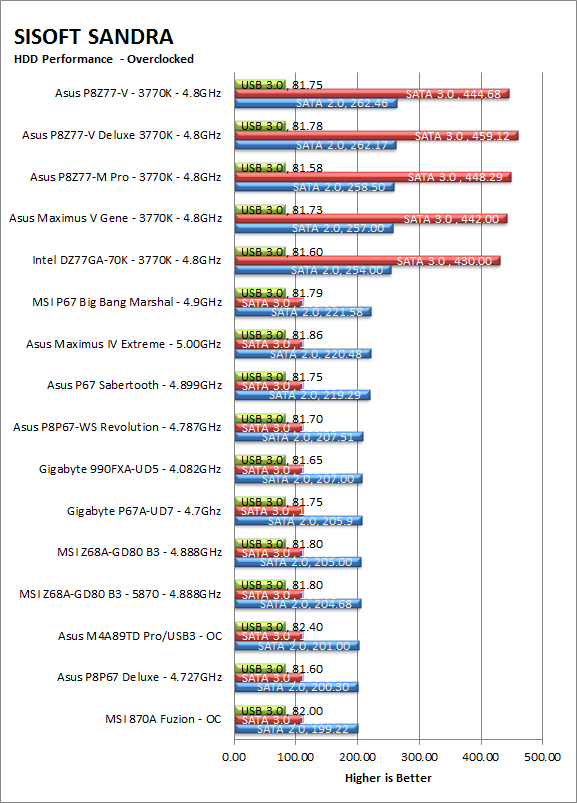
For USB 3.0 performance the –V Deluxe also has the USB 3.0 Boost and with this running we saw performance gains of up to 70MB/s with our Kingston DataTraveler Hyper X (from 254.10 to 275.4). This makes it faster than what we can get from an SSD on the SATA 2.0 controller!
Power -
Power efficiency is another of those misnomers that we get caught up in. We hear about idle states and power gates. But what does that mean to you and I? On the surface having power management that reduces idle power sounds great and can be a benefit to someone that leaves their system on for long periods of time (and inactive) but how a system handles power under load and the delta between the two states is often more important than the idle power usage numbers. We use only P3 Kill A Watt instruments for measuring power. 
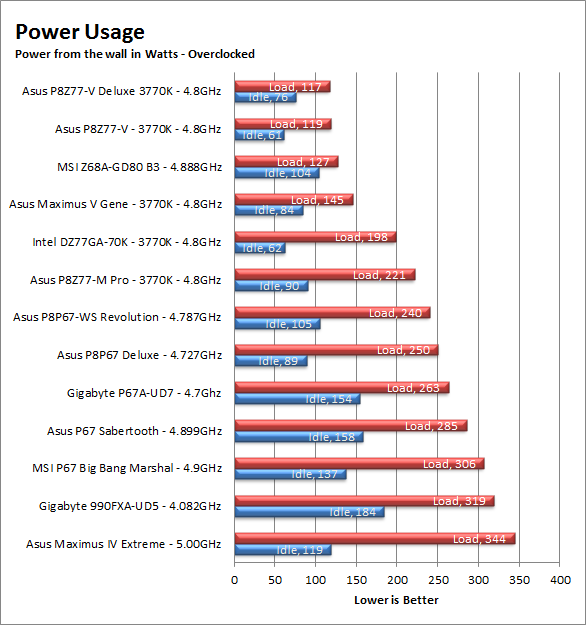
The power draw on the P8Z77-V Deluxe with everything installed (WiFi etc.) and just the 3770k in the motherboard pulls mere 115 Watts under load. This is not bad at all considering what is on the board. When overclocked we only saw a 2Watt jump in power draw under the same set of load conditions. However, once we dropped in the Asus EAH5870 V.2 we saw the efficiency drop quite a bit with load draws of 231 and 263 for stock and overclocked performance.
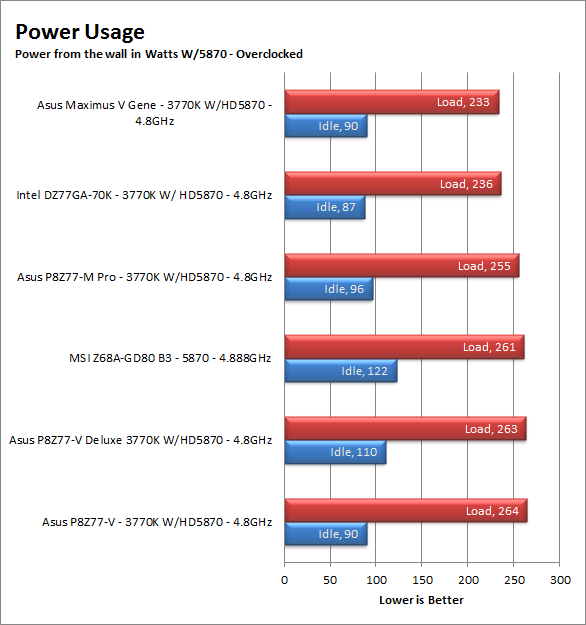
Cooling (Board Level) -
Board level cooling is an important factor in product performance and longevity. Components like the chipset, VRM modules and even capacitors need to be kept relatively cool to prevent failure. As these parts are made of silicon, they have a thermal breakdown threshold; or melting point. At that temperature the actual transistors built into chip will begin to deform and break down. Granted, the threshold is often very high, but you still need to make sure that components stay away from this level of heat for longer product life. 
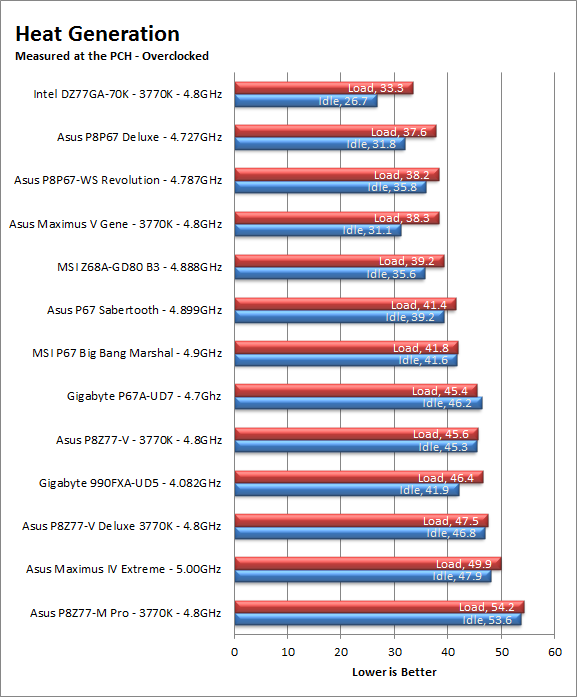
The P8Z77-V Deluxe ran hotter than we thought it would It was even a couple of degrees above the –v. This could be due to the extra components putting a bigger strain on the PCH, but not matter what the cause it is something that you will want to keep an eye on. 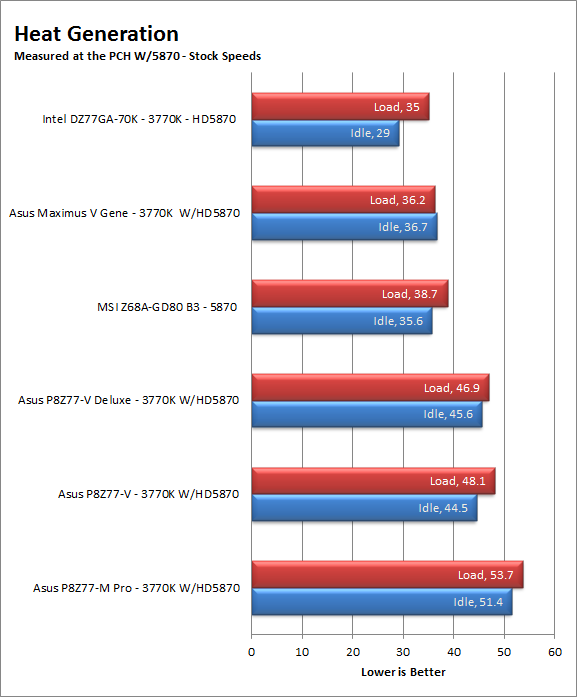
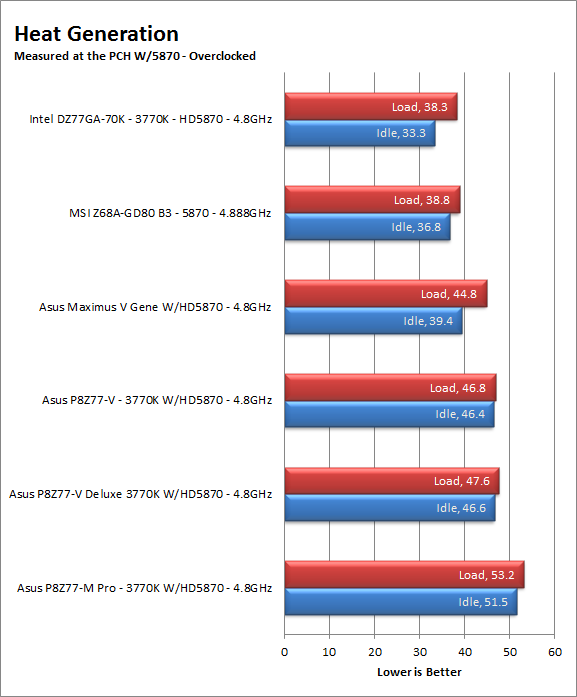
Audio -
Audio is highly subjective. What we find pleasing may sound “off” to you. That is always going to the problem with testing audio; results will vary too widely depending on the tastes of the listener. However, there are ways of measuring the audio output with an objective ear. There is also the issue of audio causing performance issues in gaming and video playback. The reason this is a potential source of concern is that all onboard audio CODECs (Compression/Decompression) are CPU controlled. This means that while the audio chip controls the audio levels and effects of the audio the actual work is done on the CPU. Usually this will not be a problem with today’s powerful CPUs. Even the lower and consumer level products can handle high-end audio these days. But again there is the chance that a bad design or software will hinder your system and performance. On the other side the limits of board space, cost, etc will also prevent the level of audio quality you can get from an add-in board. We test all audio parts with three media types, Movie (DVD), MP3 Music, and Gaming. These are pushed to our Tec On model 55 Tube Amp to see if we can detect any signal issues in the reproduction.
The audio on the –V Deluxe is pretty solid with the dts Connect and dts UltraPC II adding to the audio quality in noticeable ways. This is not award winning audio, but it is better than the typical “good enough” audio that we have seen on more than a few motherboards. On the model 55 we did notice a little bit of tin at the upper end. This was almost like a vibration more than an actual sound and only appeared when there were sustained high frequency sounds (like metal scraping).
Networking -
This one is something that is a requirement anymore. If you have a computer, the chances are good (like 99%) that you are also connected to high-speed internet. With this you need a good and solid LAN chip to make sure that your data flows properly out and back.
The Intel LAN combined with Asus’ new iConnect QoS software makes for a very quick internet connection as long as you have your profile setup correctly. The software is exceptionally easy to use and allows you to setup multiple profiles depending on what you are doing. You can also setup a schedule so that during certain times of the day applications can get priority. This makes it very flexible as we mentioned there was a noticeable improvement in applications that we gave high priority to. (while running other network intensive applications).
Section II - Performance Tests, Synthetic
In this section of testing we cover the synthetics. These are tests that run a scripted sequence of internal APIs or that use another installed application to perform a series of scripted events. They are great in that they can provide reproducible results across various platforms. On the down side, synthetic tests can be fooled with driver tweaks and optimizations. In some cases it is necessary to rename the .exe file to something generic to discover if this is the case. In any event when this is needed (when a test shows a drastic difference in performance over the renamed exe) we will note this and show both results for comparison.
PCMark7 -
PCMark7 is the latest general performance test from FutureMark. As each generation of this benchmark has evolved and developed we have watched them add more and more realistic tests to this suite. With this generation we find more media tests, (audio and video transcoding) moving of large files, multiple web page rendering, and much more (the even added DX10 gaming). We use the Overall Performance and Common Usage suites in our testing.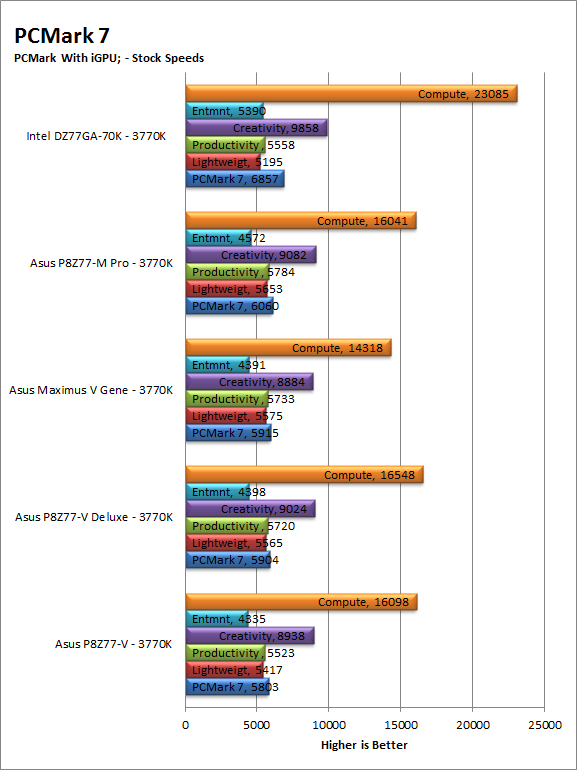
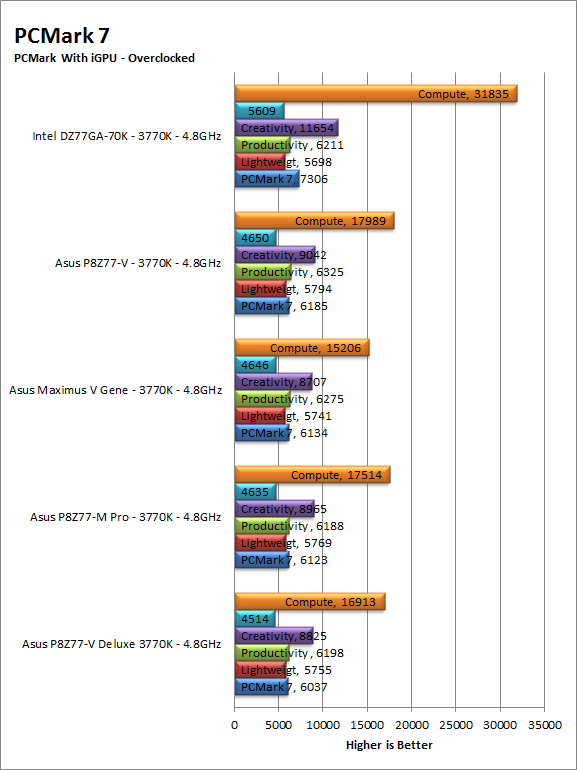
Under the stress of PCMark07 the P8Z77-V Deluxe does fairly well coming in a few points behind the Intel DZ77GA-70K when we had the EAH 5870 V.2 in the system. With just the GMA 4000 to push graphics the –V Deluxe drops back a few places though and comes in just behind the Maximus V Gene. Even with its place in the ranks we still expect to see good performance in the rest of our tests and you should not have any issues in general computing. 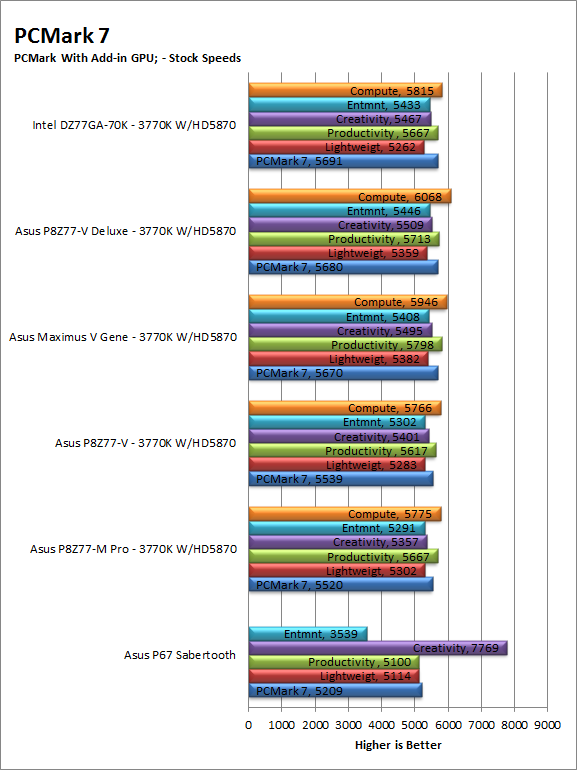

3DMark 11 -
3DMark 11 is the other Futuremark test that we run on our motherboards. This test simulates the typical tasks that a GPU (and system) would have to perform to provide you with a good gaming experience. It is based on the DX9, DX10 and DX11 engines but can only be installed on Windows Vista or later. The suite of tests covers DX9, DX10, and of course DX11 rendering; it also covers AI computations and physics. That’s right I said Physics the latest version of 3DMark uses a Havok physics engine. This removes the advantage that nVidia had with 3DMark Vantage. 

In 3DMark 11 we find the –V Deluxe back up at the top of the group. At when we had the EAH 5870 in the system. Under the power of the GMA 4000 we find that the –V Deluxe drops back a little although it is not that far behind the leader at stock speeds. This should mean decent gaming performance even with the GMA 4000 although you would not want to use it for high-end games. 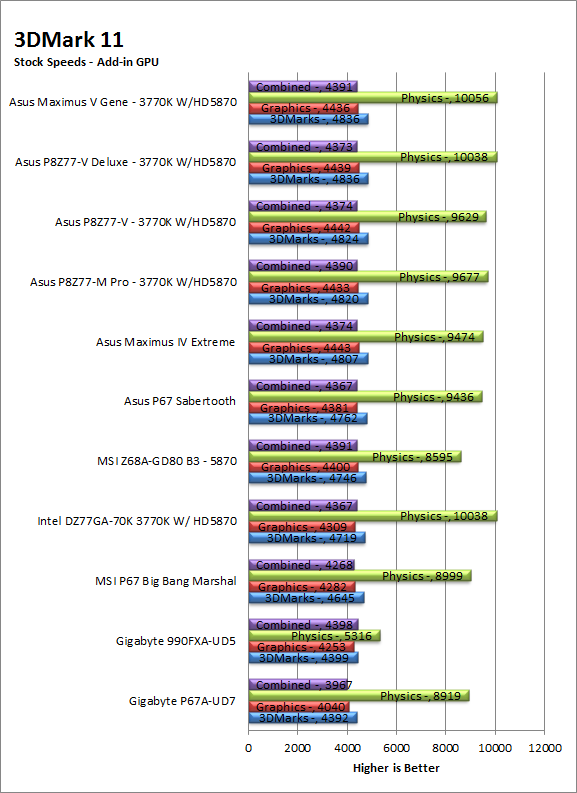
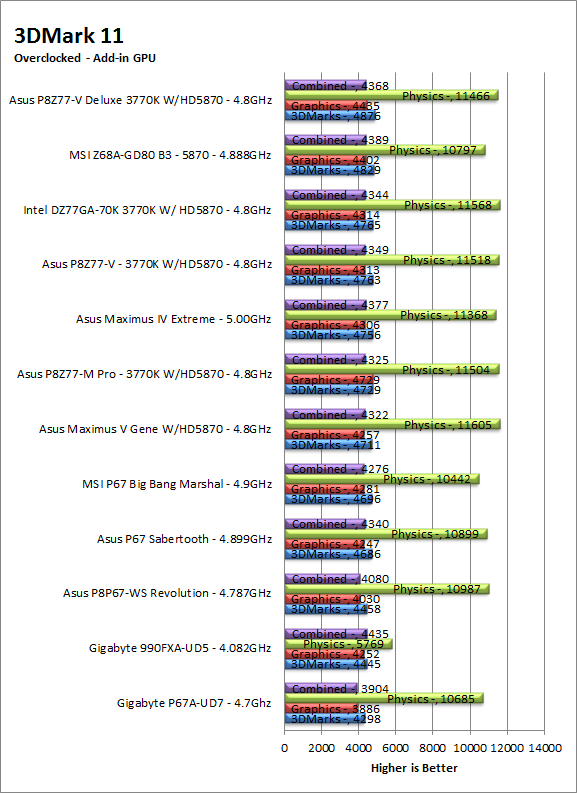
HyperPi 0.99b -
HyperPi is a front end application that allows you to easily run multiple instances of the SuperPi application. SuperPi, for those that are not familiar with it, is an application that measures the time it takes to calculate the number Pi out to as many as 32 million places. This calculation is then checked and run multiple times (up to 24 for a 32M run). This test stresses the CPU, Memory and HDD as data is handed off between the three. If there is a weak link, HyperPi will show it. For our testing we run the 32M test on as many cores (and threads) as the CPU has available. The slowest CPU time is then recorded. 
The –V Deluxe shows off its number crunching ability here with our HyperPi 0.99b testing. This handy little test shows us that the CPU to Memory to HDD paths are quite quick. This should mean good transcoding, rendering and editing performance with the right hardware. 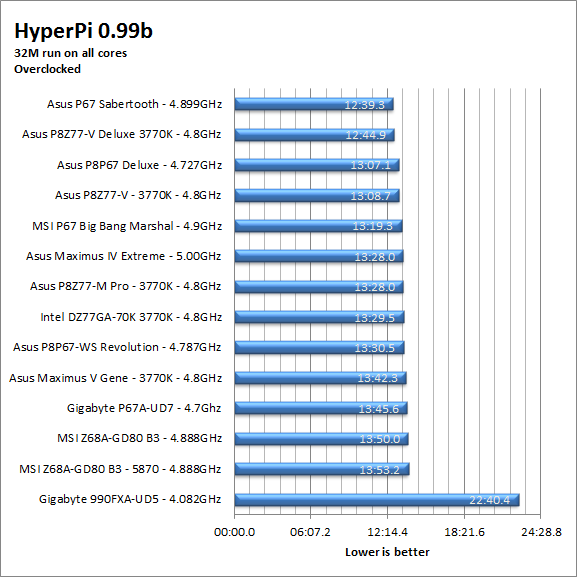
Cinebench R11.5 -
Cinebench R11.5 is the 11th release of Maxon’s rendering test. This test is based off of the Cinema 4D engine, which is one of the industry standard tools for digital animation. It is a powerful product with many different modules that can be “plugged” into it to increase its effectiveness. With Cinebench you get to see how your computer would do using this application. There are two tests; one tests the CPU’s ability to render an image across multiple cores or threads. The other tests your systems ability to handle OpenGL based rendering.
| Cinebench CPU Rendering Stock | Cinebench CPU Rendering Overclocked |
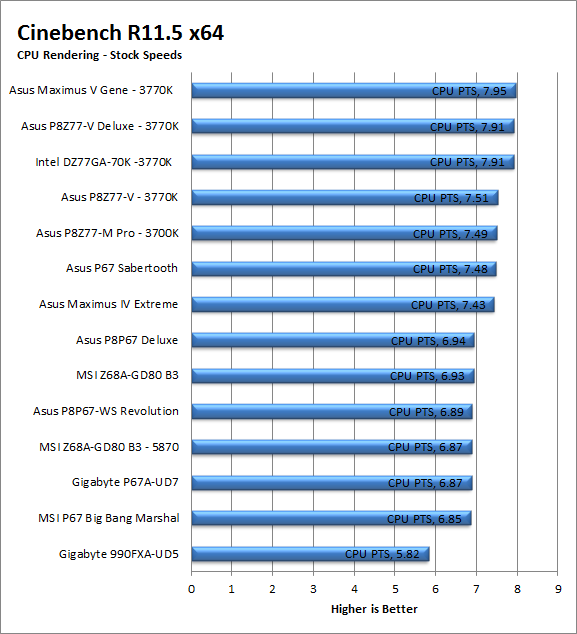 |
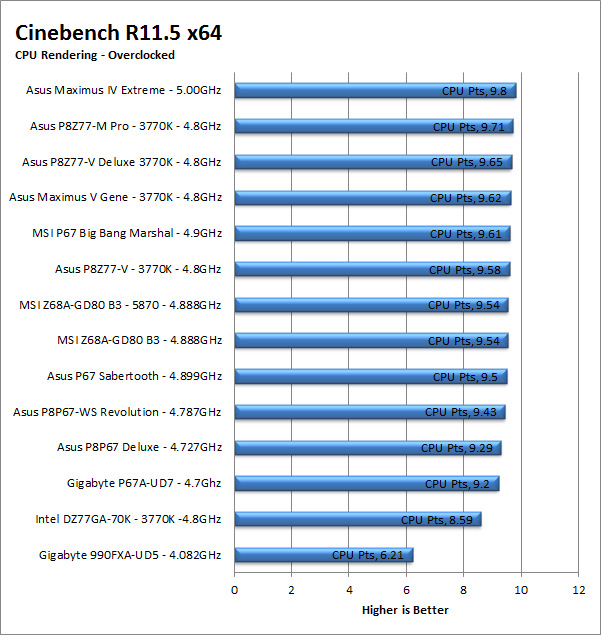 |
The –V Deluxe also does very well with Cinebench R11.5, at least at stock speed. When we overclocked the board we found that the performance dropped off a little. Still 9.65 is a nice number in this test and shows that the –V Deluxe could handle professional work if you used it for this.
| Cinebench OpenGL Rendering Stock | Cinebench OpenGL Rendering Overclocked |
 |
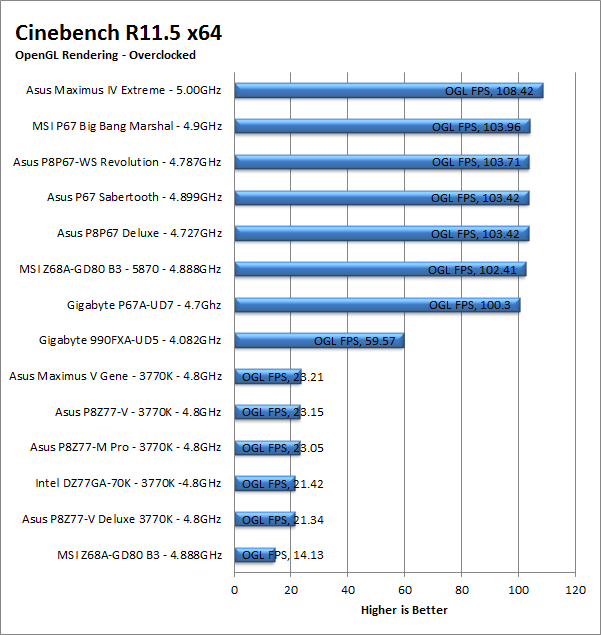 |
Section III - Performance Tests, Real-World
Here we have two tests that are designed to put the performance of the motherboard and its subsystems to the test. Both require good CPU, Memory, HDD and even to a lesser extent audio and network performance. The two tests we chose were Lightwave 3D 9.6 and CyberLinks's Media Espresso 6.5. We will be adding at least one more real-world test to this battery in the near future, but for now these two cover quite a bit.
Lightwave 3D 9.6 x64 -
Lightwave is another industry standard application for 3D animation and rendering. It has a large tool base and the rendering engine is highly threaded (when using the right render model). This application is also capable of expanding to 4k resolutions as well as ray tracing for rending the light sources. For our testing we use frame 470 of the Pinball scene found in the LW 9 Content folder. This uses the newer perspective camera that is better suited to a multi-CPU/Core environment. This camera style also uses ray tracing and a much improved anti-aliasing method. Settings are shown below in the attached screen shot. Of course these are single frame renders and they are not a complete picture; for that you have to take into account the number of frames an average project would have. In a typical 30 second commercial you will have around 840 to 960 frames (at 28 – 32 FPS) this means that you have to multiply the time of a single frame by that number just to get a vague idea of how long that 30 seconds would take. This is because each frame will have a different render time based on complexity.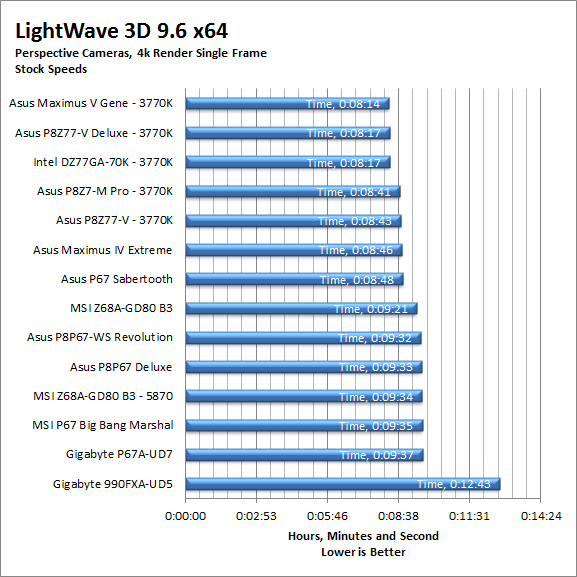
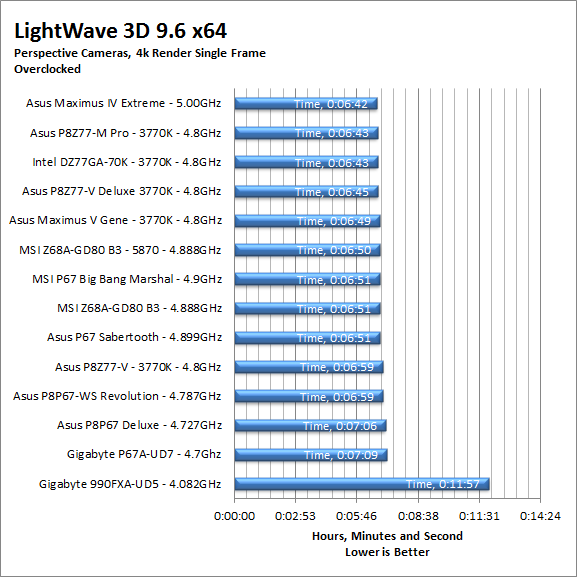
The P8Z77-V Deluxe was able to cut through our LightWave testing without any issues at stock speeds. We did see the performance drop off when overclocked (yes this is a trend), but the drop was not massive. It still is enough to have a noticeable effect on our project time. We imagine that Asus will need to tweak the BIOS a little to improve the performance scaling between stock and overclocked. 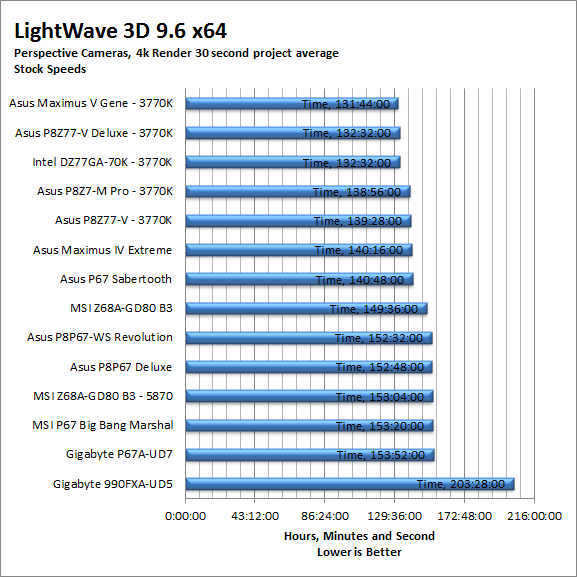
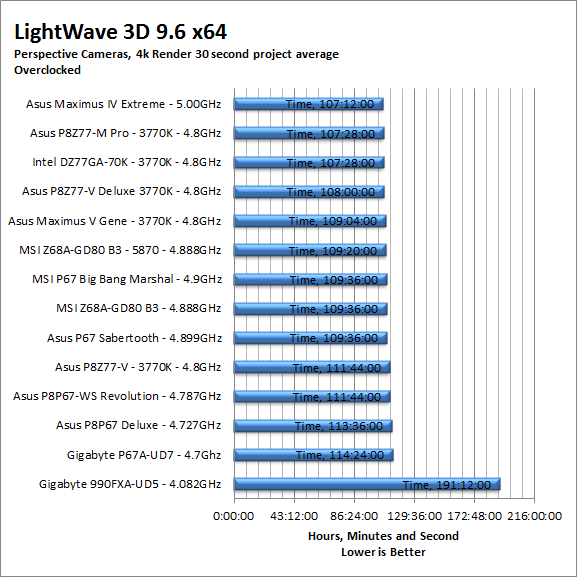
CyberLink Media Espresso 6.5 -
After having various issues with AutoGK and Intel CPUs with more than four cores we have changed our Media Encoding test to use Media Espresso from CyberLink. Although this new utility does not have the same ability to transfer directly from DVD it is still a good test to transfer different media types into a usable format for your iPad, iPod, or other media player. Our test involves using multiple (Six) 20 minute media files and transcoding them for an iPad. This gives us a very good indication of how well a motherboard can handle this type of work load.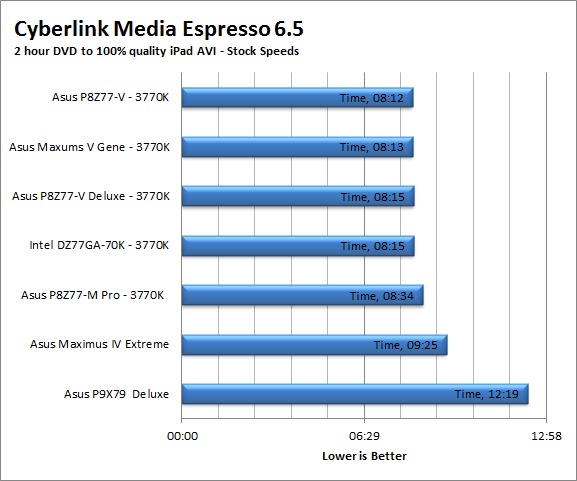
All of the transcoding times for the Z77 based boards are within a few seconds of each other which makes it hard to say which one is “better” sure we can call a winner, but it would not be a good representation of the actual information. In reality Ivy Bridge brings some very efficient processing power to the tablet which allows you to cut through the video transcode in very short order. 
Section IV Performance – Gaming
Gaming as a test of motherboard performance is sort of a joke these days. The big player in the gaming arena is the GPU. Everyone but a few hardcore PR teams know this. However, it is important to run at least a few (one from each current DX version) to see if there are any issues with the combination of components on a motherboard. These are items like Audio lag, memory lag and of course problems with the PCIe lanes and signal traces. If there are issues in design, drivers or BIOS then you can have odd gaming performance. So without much more preamble let’s dive into the three games we currently use; Call of Duty Modern Warfare 2 for DX9 FarCry 2 for DX10 and Battlefield Bad Company 2 for DX11.
Call of Duty Modern Warfare 3 DX9 -
As the third installment in the Modern Warfare franchise you are picking up some old roles while adding a couple of new ones as well. The game play is almost identical to what you are used to in Modern Warfare 2 as are the graphical settings. The AI is a little different thought it is still similar to the bar fight style AI we like in the Call of Duty series. For our testing we run the first mission (Black Tuesday) from start to finish. Settings are shown below
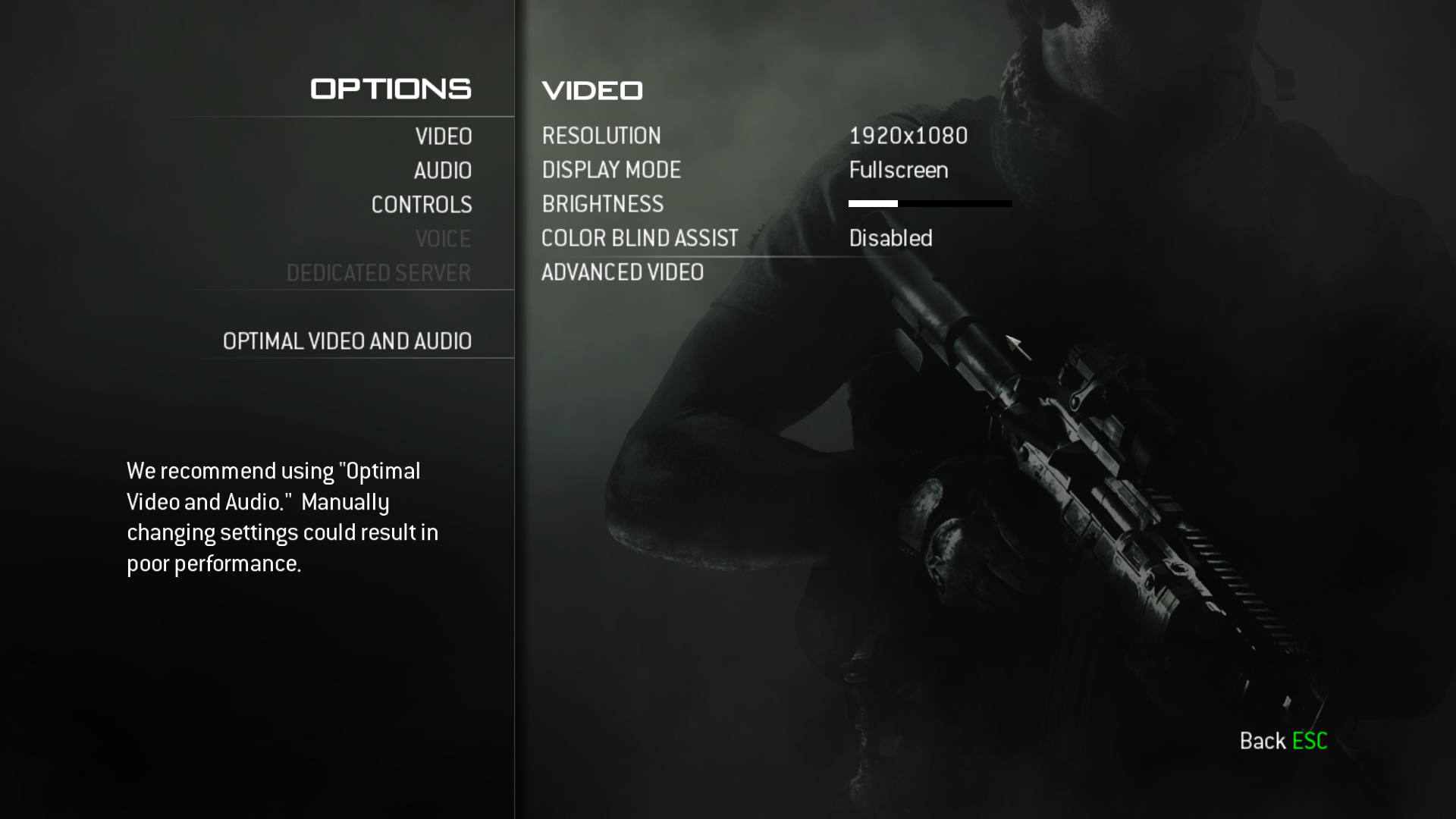 |
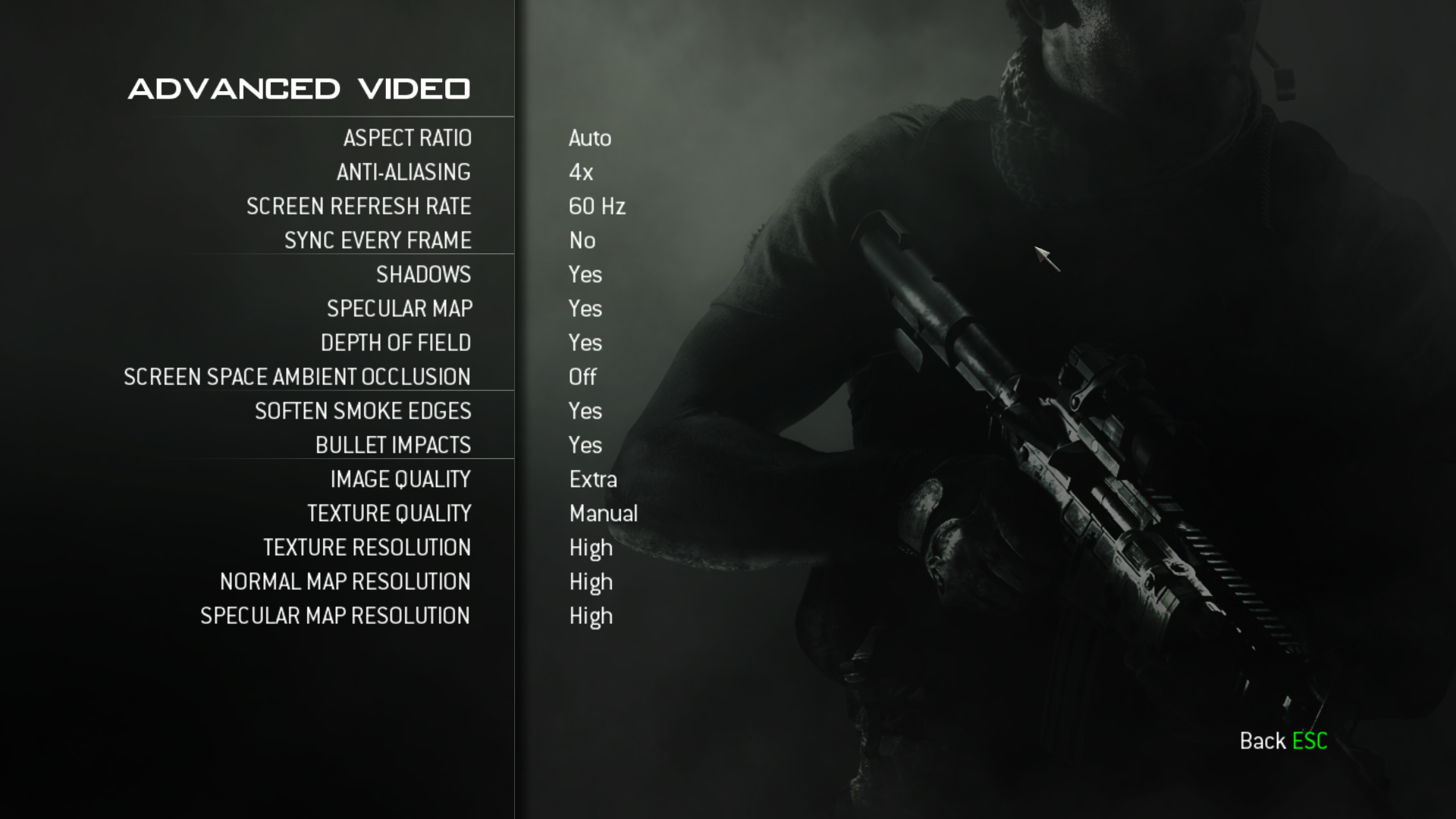 |
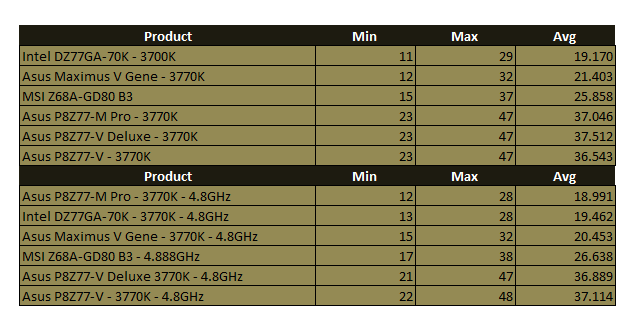
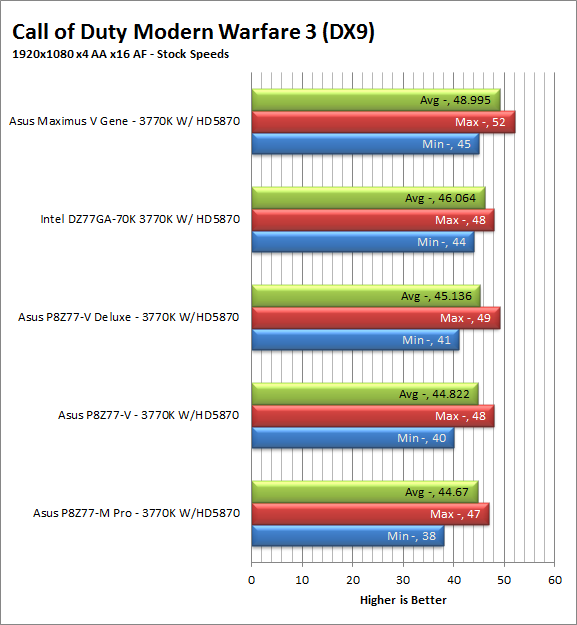
Modern Warfare 3 is one of the only modern FPS (First Person Shooter) games that plays very well on the GMA 4000 iGPU. We have actually played through the entire game with just this and found that it is not a bad experience at all. This is good for some casual gamers that might want to step out of the less graphically intense games and hit up something a little more aggressive. With the EAH5870 V.2 the frame rates only continued to improve. 
FarCry2 DX10 -
Although not one of my favorite games this tedious game does have some good graphics. The large sandbox style of the game lends to mission based play. The only problem is that the AI is rather low grade. Still the more CPU power the more the bad guys try to do. Over all the game was a little bit of a disappointment to play, but still not a bad DX10 representation. Our testing run starts right after you get your first mission to clean out the safe-house and ends after the hostage rescue. Settings and performance numbers are shown below.
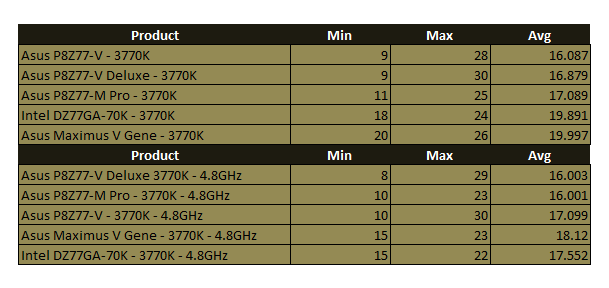
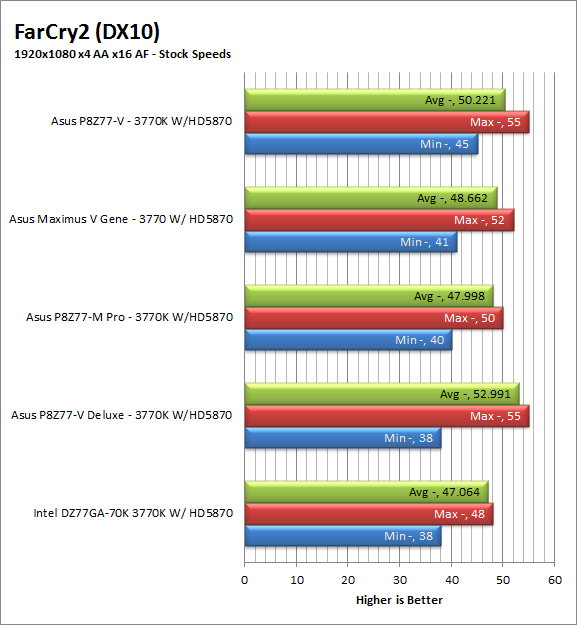
Well,… if you are looking to play FarCry2 all we can say is make sure you get an Add-in card. Once you do you will find that the P8Z77-V Deluxe does a solid job of running FarCry2 for you. 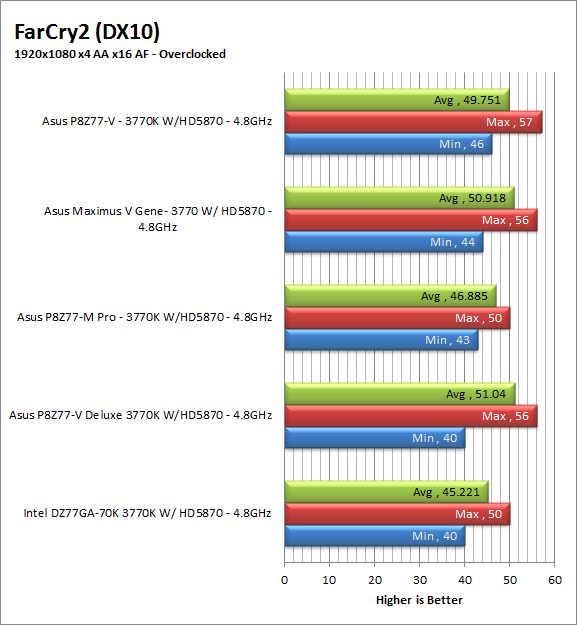
Crysis 2 DX11 –
Another sequel Crysis 2 follows up on two other Crysis games (making the title a little misleading). You take the role of a Force Recon Marine who is given a battle suit by a character named Profit (you will remember him from the other two Crysis games). From there you run around an Infected and Invaded New York City trying to survive and, of course, save the planet. For our testing we ran through the first “mission”. Settings are shown below.
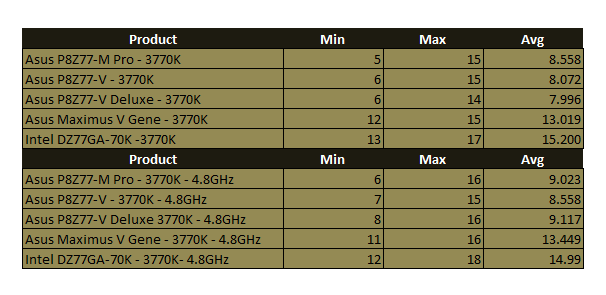

As with FarCry2 do not try to play Crysis 2 with just the iGPU on the P8Z77-V Deluxe or any Z77 board for that matter. Once you do get your GPU in the system you should still have pretty solid performance. 
Gaming wrap-up -
The Asus P8Z77-V Deluxe is a good board if you are looking to game. Although it was not at the top of our list in many cases the difference in frame rate was around 5FPS max. This means that you would not be able to see the difference on the monitor. What you will notice is slightly faster level loads, better audio (than many of the other systems) and a very smooth feel to the games overall.
Value -
Value is another very subjective topic. What is expensive to some might be a deal to others. You can look at this topic in multiple ways. One is raw price and the other is what you get for the money. Each is accurate and both are correct ways to look at price/value. We tend to look at features, performance and real-property when we discuss value. However, we also take into account the raw cash cost of the item.
At $275 from your average etailer the P8Z77-V Deluxe is starting to creep up in terms of pricing. You are getting more features that help to offset this cost, but many might still look at the overall price and be deterred. In our estimation you are getting a pretty good deal when you look at everything. You are getting dual LAN (although dual Intel would have been nicer) as well as dual band wireless+ Bluetooth controller. This adds at least $50 to the value of the board so at $275 you are not doing too bad.
Conclusion -
The Asus P8Z77-V Deluxe has a complicated board. You have a lot going on when you drop one of these inside your favorite case. We are impressed with the new wireless remote suite of tools that Asus has dropped in with everything from remote desktop to simple keyboard and mouse available for you to use. We do wish that you could set this up over the wired connection, but maybe Asus will add that in later. On the performance side we were happy with the stock performance where the P8Z77-V Deluxe came in just behind the lead spot in most of our tests. We were not as happy with the overclocked performance where the system seemed to drop off during testing. More than likely this will be addressed in a new BIOS, but for now it is what it is. Still you would not go wrong dropping the Asus P8Z77-V Deluxe into your system. We found it more than powerful enough to get the job done and had a very broad selection of features that make it a good buy.
We are happy to award the P8Z77-V Deluxe our Silver Key for its performance, features and flexibility.
Discuss in our Forum

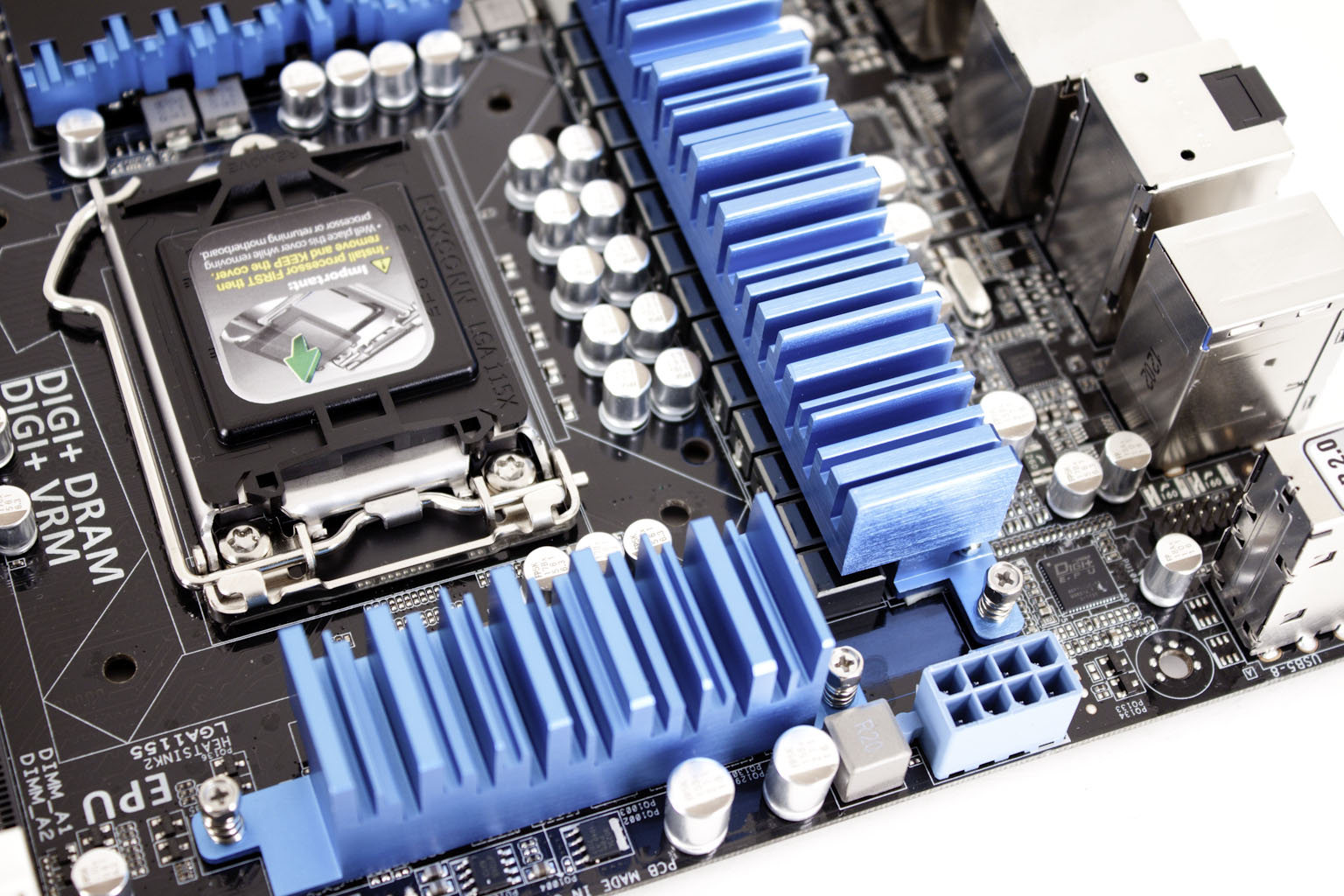 After what seemed like a long time we are finally getting into the full performance section of our review. The Asus P8Z77-V Deluxe is a board that really has quite a bit going on which makes properly covering everything something of a chore. You can check out our
After what seemed like a long time we are finally getting into the full performance section of our review. The Asus P8Z77-V Deluxe is a board that really has quite a bit going on which makes properly covering everything something of a chore. You can check out our 

